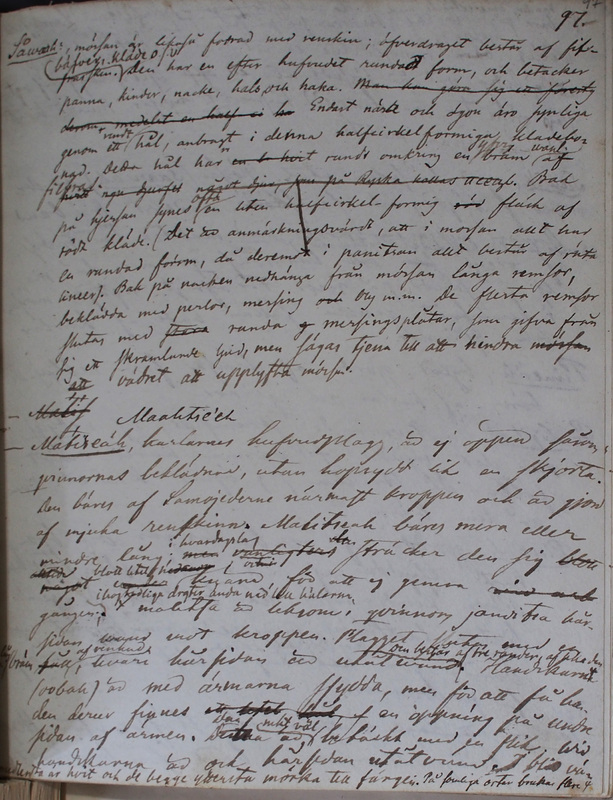Ethnographiska, historiska och statistiska anmärkningar. 097
Title
Ethnographiska, historiska och statistiska anmärkningar. 097
Description
|
Såwaah:
mössan är likaså sotrad med renskinn; öfverdraget består af filTN сава ʻhat’. According to Chomič, there are several types of hats among the Nenets women and Castrén’s description comes close to TN няндуй (сава), a semi-circular hat with long earflaps and two decorated reindeer skin belts at the back. In addition, there are hats without back decorations and with a circular bottom and short earflaps. (IEAS 1961: 329, 339; Chomič 1966: 126–130)
frasskin bäfver, kläde o.s.v. Den har en efter hufvudet rundat form, och betacker panna, kinder, nacke, hals och haka. Man kan göra sig ett föresty derom medelst en half Endast näsa och ögon äro synliga genom ett rundt hål, anbragt i denna halfcirkelformiga klädebo- nad. Detta hål har en hvit rundt omkring en ytterst bräm vanligen af filfras ngn djuret något djur, som på Ryska kallas псець. Bak på hjessan synes ofta en liten halfcirkel-formig röd fläck af rödt kläde. (Det äro anmärkningsvärdt, att i mossan allt har en rundad form, då deremot i panitsan allt består af rikta lineer). Bak på nacken medhänga från mössan långa remsor, beklädda med perlor, messing och bly m.m. De flesta remsor slutas med stora runda g messingsplåtar, som gifva från sig ett skramlande ljud, men sägas tjena till att hindra mössan att vädret att upplyfta mössan. |
Såwaah the hat is also lined with reindeer skin; the cover consists of Arctic fox, beaver, cloth, etc. It has a rounded shape over the head, and it covers the forehead, cheeks, neck, throat, and chin. Only the nose and eyes are visible through a round hole placed in this semicircular piece of clothing. This hole has a white surround around the outer edge, usually of Arctic fox fur. On the top of the head, there often appears a small semicircular red spot made of red cloth. (It is remarkable that everything has a rounded shape in the hat, whereas in the panitsa everything consists of straight lines.) At the back on the neck, long strips hang from the hat, lined with pearls, brass, lead, etc. Most strips end with large round brass plates, which make a rattling sound, but are said to prevent the weather from lifting the hat. |
|
Maliseáh
Maalitse'eh, karlarnes hufvudplagg, är ej öppen såsomTN мальця, Ru malica denots a closed, often hooded men’s fur garment, a parka, with fur sewn inside. Gloves, TN ңоба, are typically sewn into the end of the sleeves and the hem is made of some fur, as described by Castrén. A belt, TN ни, is fastened in such a way that the garment forms a pouch above the belt. The pouch, TN маʹ, serves as a pocket. (Chomič 1966: 116–119; IEAS 1961: 227, 240; Golovnev Kukanov, & Perevalova 2018: 238–243)
qvinnornas beklädnad, utan hopsydt lik en skjorta. Den bäres af Samojederne närmast kroppen och är gjord af mjuka renskinn. Malitseah bäres mera eller mindre lång; hvardagslagmen vanligtvis sträcker den sig blott blott litet [under] knärna, för att ej genera gången <i högknädliga dr[a]gter ända ned till hälarna>. Malitsa är liksom qvinnorns janditsa hår- sidan wand emot kroppen. Plagget slutas med en lång bräm af renhud hvari hårsidan är utåt wand. och består af tre rander af hka[hvilka] den.Handskarna (oobah) är med ärmarna sydda, men för att få han den deruv finnes en öppning på andra sidan af armen. Detta är mkt[mycket] väl betäckt med en flik wid handskarna är ock hårsidan ut åt vund. Medlersta är hvit och de begge yttersta mörka till färgen. På somliga orter brukas flere |
The maalitse'eh the main menʼs garment, is not open like women’s clothing, but sewn closed – like a shirt. It is worn by the Samoyeds closest to the body and is made of soft reindeer skin. The malitseah is worn more or less long; it usually only extends slightly below the knees <so that it would not hamper walking in areas with flood up to the heels>. The malitsa is like the women’s janditsa; the side with the hair is against the body. The cloth ends with a long brim of reindeer skin with the fur facing outwards and consists of three strips. Gloves (oobah) are sewn together with the sleeves, but to get the hands out, there is an opening on the other side of the sleeve. This is very well covered with a strip as wide as the gloves. The gloves are also sewn with the fur side facing outwards. The middle part is white and the two upper parts are dark in colour. In some places more |

